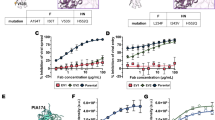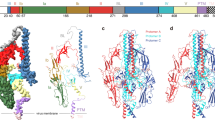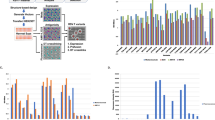Abstract
Antibody-mediated neutralization may interfere with the efficacy of measles virus (MV) oncolysis. To circumvent vector neutralization, we sought to exchange the envelope glycoproteins, hemagglutinin (H) and fusion (F), with those from the non-crossreactive Tupaia paramyxovirus (TPMV). To sustain efficient particle assembly, we generated hybrid glycoproteins with the MV cytoplasmic tails and the TPMV ectodomains. Hybrid F proteins that partially retained fusion function, and hybrid H proteins that retained fusion support activity, were generated. However, when used in combination, the hybrid proteins did not support membrane fusion. An alternative strategy was developed based on a hybrid F protein and a truncated H protein that supported cell–cell fusion. A hybrid virus expressing these two proteins was rescued, and was able to spread by cell fusion; however, it was only capable of producing minimal amounts of particles. Lack of specific interactions between the matrix and the H protein, in combination with suboptimal F-protein processing and inefficient glycoprotein transport in the rescue cells, accounted for inefficient particle production. Ultimately, this interferes with applications for oncolytic virotherapy. Alternative strategies for the generation of shielded MV are discussed.
This is a preview of subscription content, access via your institution
Access options
Subscribe to this journal
Receive 12 print issues and online access
$259.00 per year
only $21.58 per issue
Buy this article
- Purchase on SpringerLink
- Instant access to full article PDF
Prices may be subject to local taxes which are calculated during checkout







Similar content being viewed by others
References
Cattaneo R, Miest T, Shashkova EV, Barry MA . Reprogrammed viruses as cancer therapeutics: targeted, armed and shielded. Nat Rev Microbiol 2008; 6: 529–540.
Liu TC, Galanis E, Kirn D . Clinical trial results with oncolytic virotherapy: a century of promise, a decade of progress. Nat Clin Pract Oncol 2007; 4: 101–117.
Garber K . China approves world’s first oncolytic virus therapy for cancer treatment. J Natl Cancer Inst 2006; 98: 298–300.
Parks R, Evelegh C, Graham F . Use of helper-dependent adenoviral vectors of alternative serotypes permits repeat vector administration. Gene Therapy 1999; 6: 1565–1573.
Rose JK, Bergmann JE . Altered cytoplasmic domains affect intracellular transport of the vesicular stomatitis virus glycoprotein. Cell 1983; 34: 513–524.
Galanis E, Hartmann LC, Cliby WA, Long HJ, Peethambaram PP, Barrette BA et al. Phase I trial of intraperitoneal administration of an oncolytic measles virus strain engineered to express carcinoembryonic antigen for recurrent ovarian cancer. Cancer Res 2010; 70: 875–882.
Msaouel P, Dispenzieri A, Galanis E . Clinical testing of engineered oncolytic measles virus strains in the treatment of cancer: an overview. Curr Opin Mol Ther 2009; 11: 43–53.
Russell SJ, Peng KW . Measles virus for cancer therapy. Curr Top Microbiol Immunol 2009; 330: 213–241.
Griffin DE . Measles virus. In: Fields B, Knipe DM, Howley PM, (eds) Fields’ Virology. 5th edn Vol. 1. Lippincott Williams and Wilkins Philadelphia, 2007 pp 1551–1585.
Miest TS, Yaiw KC, Frenzke M, Lampe J, Hudacek AW, Springfeld C et al. Envelope-chimeric entry-targeted measles virus escapes neutralization and achieves oncolysis. Mol Ther 2011; 19: 1813–1820.
Tidona CA, Kurz HW, Gelderblom HR, Darai G . Isolation and molecular characterization of a novel cytopathogenic paramyxovirus from tree shrews. Virology 1999; 258: 425–434.
Springfeld C, von Messling V, Tidona CA, Darai G, Cattaneo R . Envelope targeting: hemagglutinin attachment specificity rather than fusion protein cleavage-activation restricts Tupaia paramyxovirus tropism. J Virol 2005; 79: 10155–10163.
Cathomen T, Mrkic B, Spehner D, Drillien R, Naef R, Pavlovic J et al. A matrix-less measles virus is infectious and elicits extensive cell fusion: consequences for propagation in the brain. EMBO J 1998; 17: 3899–3908.
Cathomen T, Naim HY, Cattaneo R . Measles viruses with altered envelope protein cytoplasmic tails gain cell fusion competence. J Virol 1998; 72: 1224–1234.
Enkirch T, Kneissl S, Hoyler B, Ungerechts G, Stremmel W, Buchholz CJ et al. Targeted lentiviral vectors pseudotyped with the Tupaia paramyxovirus glycoproteins. Gene Therapy 2013; 20: 16–23.
Spielhofer P, Bachi T, Fehr T, Christiansen G, Cattaneo R, Kaelin K et al. Chimeric measles viruses with a foreign envelope. J Virol 1998; 72: 2150–2159.
Hu A, Cathomen T, Cattaneo R, Norrby E . Influence of N-linked oligosaccharide chains on the processing, cell surface expression and function of the measles virus fusion protein. J Gen Virol 1995; 76: 705–710.
Funke S, Maisner A, Muhlebach MD, Koehl U, Grez M, Cattaneo R et al. Targeted cell entry of lentiviral vectors. Mol Ther 2008; 16: 1427–1436.
Cathomen T, Buchholz CJ, Spielhofer P, Cattaneo R . Preferential initiation at the second AUG of the measles virus F mRNA: a role for the long untranslated region. Virology 1995; 214: 628–632.
Reyes-del Valle J, Devaux P, Hodge G, Wegner NJ, McChesney MB, Cattaneo R . A vectored measles virus induces hepatitis B surface antigen antibodies while protecting macaques against measles virus challenge. J Virol 2007; 81: 10597–10605.
Rager M, Vongpunsawad S, Duprex WP, Cattaneo R . Polyploid measles virus with hexameric genome length. EMBO J 2002; 21: 2364–2372.
Calain P, Roux L . The rule of six, a basic feature for efficient replication of Sendai virus defective interfering RNA. J Virol 1993; 67: 4822–4830.
Nakamura T, Peng KW, Harvey M, Greiner S, Lorimer IA, James CD et al. Rescue and propagation of fully retargeted oncolytic measles viruses. Nat Biotechnol 2005; 23: 209–214.
Darai G, Matz B, Flugel RM, Grafe A, Gelderblom H, Delius H . An adenovirus from Tupaia (tree shrew): growth of the virus, characterization of viral DNA, and transforming ability. Virology 1980; 104: 122–138.
Radecke F, Spielhofer P, Schneider H, Kaelin K, Huber M, Dotsch C et al. Rescue of measles viruses from cloned DNA. EMBO J 1995; 14: 5773–5784.
Karber G . Beitrag zur kollektiven Behandlung pharmakologischer Reihenversuche. Arch Exp Pathol Pharmakol 1931; 162: 480–483.
Devaux P, von Messling V, Songsungthong W, Springfeld C, Cattaneo R . Tyrosine 110 in the measles virus phosphoprotein is required to block STAT1 phosphorylation. Virology 2007; 360: 72–83.
Nakamura T, Peng KW, Vongpunsawad S, Harvey M, Mizuguchi H, Hayakawa T et al. Antibody-targeted cell fusion. Nat Biotechnol 2004; 22: 331–336.
Navaratnarajah CK, Vongpunsawad S, Oezguen N, Stehle T, Braun W, Hashiguchi T et al. Dynamic interaction of the measles virus hemagglutinin with its receptor signaling lymphocytic activation molecule (SLAM, CD150). J Biol Chem 2008; 283: 11763–11771.
Vongpunsawad S, Oezgun N, Braun W, Cattaneo R . Selectively receptor-blind measles viruses: identification of residues necessary for SLAM- or CD46-induced fusion and their localization on a new hemagglutinin structural model. J Virol 2004; 78: 302–313.
Bagai S, Lamb RA . Truncation of the COOH-terminal region of the paramyxovirus SV5 fusion protein leads to hemifusion but not complete fusion. J Cell Biol 1996; 135: 73–84.
Tarentino AL, Trimble RB, Plummer TH . Enzymatic approaches for studying the structure, synthesis, and processing of glycoproteins. Methods Cell Biol 1989; 32: 111–139.
Buchholz UJ, Granzow H, Schuldt K, Whitehead SS, Murphy BR, Collins PL . Chimeric bovine respiratory syncytial virus with glycoprotein gene substitutions from human respiratory syncytial virus (HRSV): effects on host range and evaluation as a live-attenuated HRSV vaccine. J Virol 2000; 74: 1187–1199.
Stope MB, Karger A, Schmidt U, Buchholz UJ . Chimeric bovine respiratory syncytial virus with attachment and fusion glycoproteins replaced by bovine parainfluenza virus type 3 hemagglutinin-neuraminidase and fusion proteins. J Virol 2001; 75: 9367–9377.
Tao T, Durbin AP, Whitehead SS, Davoodi F, Collins PL, Murphy BR . Recovery of a fully viable chimeric human parainfluenza virus (PIV) type 3 in which the hemagglutinin-neuraminidase and fusion glycoproteins have been replaced by those of PIV type 1. J Virol 1998; 72: 2955–2961.
Tao T, Skiadopoulos MH, Davoodi F, Riggs JM, Collins PL, Murphy BR . Replacement of the ectodomains of the hemagglutinin-neuraminidase and fusion glycoproteins of recombinant parainfluenza virus type 3 (PIV3) with their counterparts from PIV2 yields attenuated PIV2 vaccine candidates. J Virol 2000; 74: 6448–6458.
Zokarkar A, Lamb RA . The paramyxovirus fusion protein C-terminal region: mutagenesis indicates an indivisible protein unit. J Virol 2012; 86: 2600–2609.
Renshaw RW, Glaser AL, Van Campen H, Weiland F, Dubovi EJ . Identification and phylogenetic comparison of Salem virus, a novel paramyxovirus of horses. Virology 2000; 270: 417–429.
Chua KB, Wang LF, Lam SK, Crameri G, Yu M, Wise T et al. Tioman virus, a novel paramyxovirus isolated from fruit bats in Malaysia. Virology 2001; 283: 215–229.
Drexler JF, Corman VM, Muller MA, Maganga GD, Vallo P, Binger T et al. Bats host major mammalian paramyxoviruses. Nat Commun 2012; 3: 796.
Woo PC, Lau SK, Wong BH, Fan RY, Wong AY, Zhang AJ et al. Feline morbillivirus, a previously undescribed paramyxovirus associated with tubulointerstitial nephritis in domestic cats. Proc Natl Acad Sci USA 2012; 109: 5435–5440.
Grandi P, Wang S, Schuback D, Krasnykh V, Spear M, Curiel DT et al. HSV-1 virions engineered for specific binding to cell surface receptors. Mol Ther 2004; 9: 419–427.
van den Wollenberg DJ, van den Hengel SK, Dautzenberg IJ, Cramer SJ, Kranenburg O, Hoeben RC . A strategy for genetic modification of the spike-encoding segment of human reovirus T3D for reovirus targeting. Gene Therapy 2008; 15: 1567–1578.
Douglas JT, Miller CR, Kim M, Dmitriev I, Mikheeva G, Krasnykh V et al. A system for the propagation of adenoviral vectors with genetically modified receptor specificities. Nat Biotechnol 1999; 17: 470–475.
Rauch S, Martin-Serrano J . Multiple interactions between the ESCRT machinery and arrestin-related proteins: implications for PPXY-dependent budding. J Virol 2011; 85: 3546–3556.
Chen BJ, Lamb RA . Mechanisms for enveloped virus budding: can some viruses do without an ESCRT? Virology 2008; 372: 221–232.
Acknowledgements
We thank Dr Christoph Springfeld for providing the TPMV-Fecto antibody and helpful insights into previously attempted envelope exchanges. We thank Dr Stephen Russell for providing the Vero-αHis cell line, and Dr Patricia Devaux for numerous helpful discussions. This work was supported by NIH RO1 CA 139389. The salary of AWH was provided, in part, by the Mayo Graduate School.
Author information
Authors and Affiliations
Corresponding author
Ethics declarations
Competing interests
The authors declare no conflict of interest.
Rights and permissions
About this article
Cite this article
Hudacek, A., Navaratnarajah, C. & Cattaneo, R. Development of measles virus-based shielded oncolytic vectors: suitability of other paramyxovirus glycoproteins. Cancer Gene Ther 20, 109–116 (2013). https://doi.org/10.1038/cgt.2012.92
Received:
Revised:
Accepted:
Published:
Issue date:
DOI: https://doi.org/10.1038/cgt.2012.92
Keywords
This article is cited by
-
Oncolytic virotherapy evolved into the fourth generation as tumor immunotherapy
Journal of Translational Medicine (2023)
-
MicroRNA-mediated multi-tissue detargeting of oncolytic measles virus
Cancer Gene Therapy (2014)



